Hospitality: Bar Operations - Preparing and Serving Drinks SITHFAB003
VerifiedAdded on 2023/06/04
|16
|3112
|291
Practical Assignment
AI Summary
This practical assignment focuses on various aspects of bar operations within the hospitality sector. It includes checklists for new employees, detailing duties such as bar preparation, order taking, drink preparation, and closing procedures. The assignment also covers essential steps in serving customer...
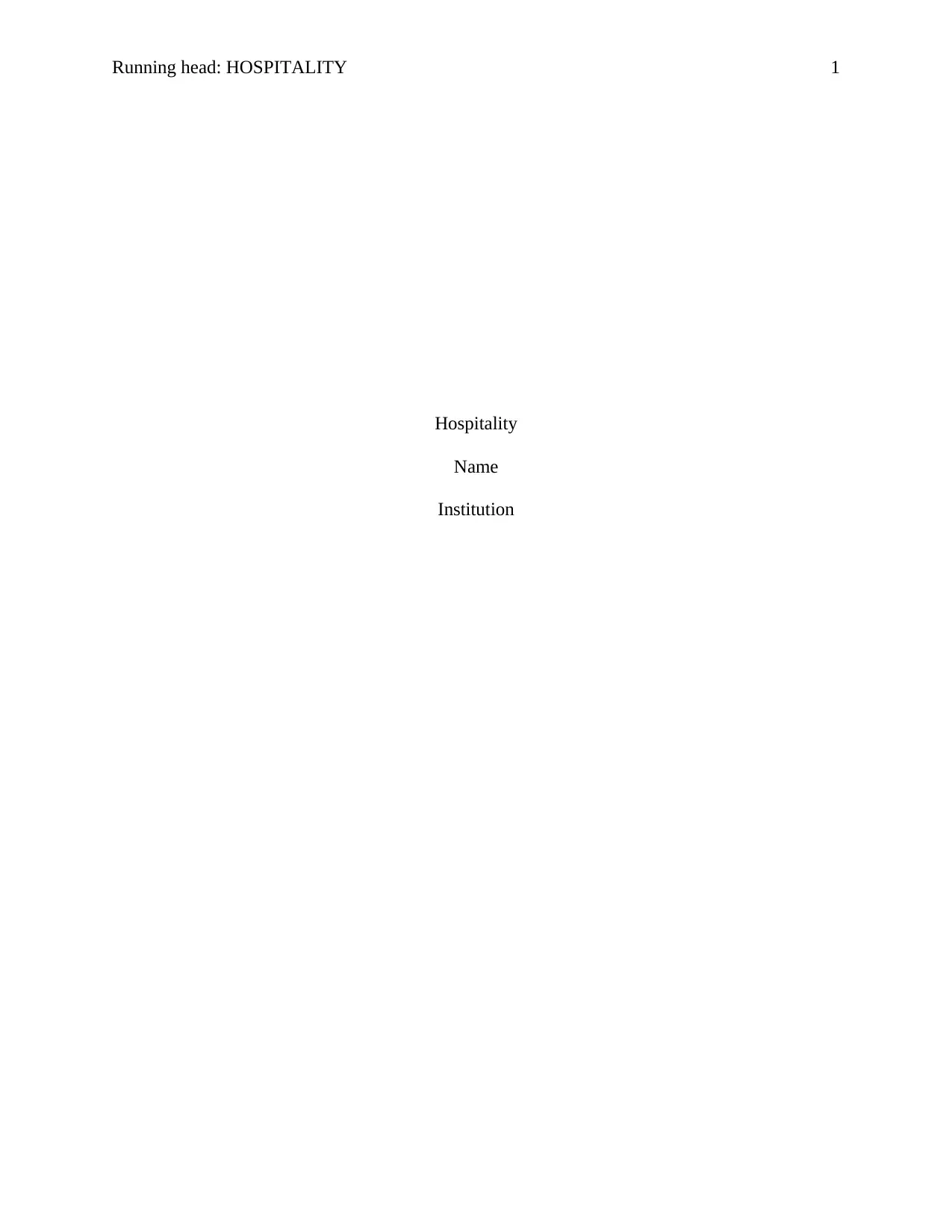
Running head: HOSPITALITY 1
Hospitality
Name
Institution
Hospitality
Name
Institution
Paraphrase This Document
Need a fresh take? Get an instant paraphrase of this document with our AI Paraphraser
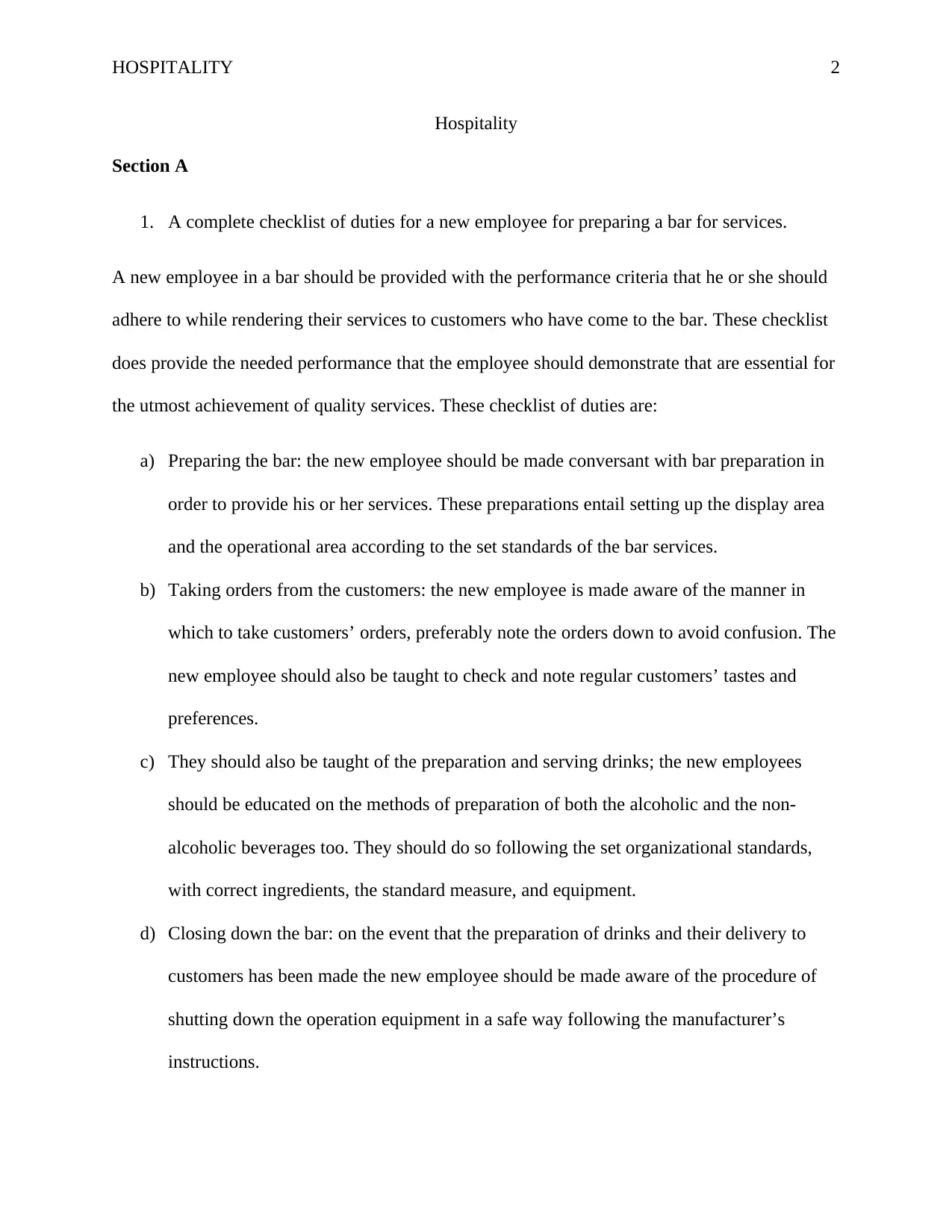
HOSPITALITY 2
Hospitality
Section A
1. A complete checklist of duties for a new employee for preparing a bar for services.
A new employee in a bar should be provided with the performance criteria that he or she should
adhere to while rendering their services to customers who have come to the bar. These checklist
does provide the needed performance that the employee should demonstrate that are essential for
the utmost achievement of quality services. These checklist of duties are:
a) Preparing the bar: the new employee should be made conversant with bar preparation in
order to provide his or her services. These preparations entail setting up the display area
and the operational area according to the set standards of the bar services.
b) Taking orders from the customers: the new employee is made aware of the manner in
which to take customers’ orders, preferably note the orders down to avoid confusion. The
new employee should also be taught to check and note regular customers’ tastes and
preferences.
c) They should also be taught of the preparation and serving drinks; the new employees
should be educated on the methods of preparation of both the alcoholic and the non-
alcoholic beverages too. They should do so following the set organizational standards,
with correct ingredients, the standard measure, and equipment.
d) Closing down the bar: on the event that the preparation of drinks and their delivery to
customers has been made the new employee should be made aware of the procedure of
shutting down the operation equipment in a safe way following the manufacturer’s
instructions.
Hospitality
Section A
1. A complete checklist of duties for a new employee for preparing a bar for services.
A new employee in a bar should be provided with the performance criteria that he or she should
adhere to while rendering their services to customers who have come to the bar. These checklist
does provide the needed performance that the employee should demonstrate that are essential for
the utmost achievement of quality services. These checklist of duties are:
a) Preparing the bar: the new employee should be made conversant with bar preparation in
order to provide his or her services. These preparations entail setting up the display area
and the operational area according to the set standards of the bar services.
b) Taking orders from the customers: the new employee is made aware of the manner in
which to take customers’ orders, preferably note the orders down to avoid confusion. The
new employee should also be taught to check and note regular customers’ tastes and
preferences.
c) They should also be taught of the preparation and serving drinks; the new employees
should be educated on the methods of preparation of both the alcoholic and the non-
alcoholic beverages too. They should do so following the set organizational standards,
with correct ingredients, the standard measure, and equipment.
d) Closing down the bar: on the event that the preparation of drinks and their delivery to
customers has been made the new employee should be made aware of the procedure of
shutting down the operation equipment in a safe way following the manufacturer’s
instructions.
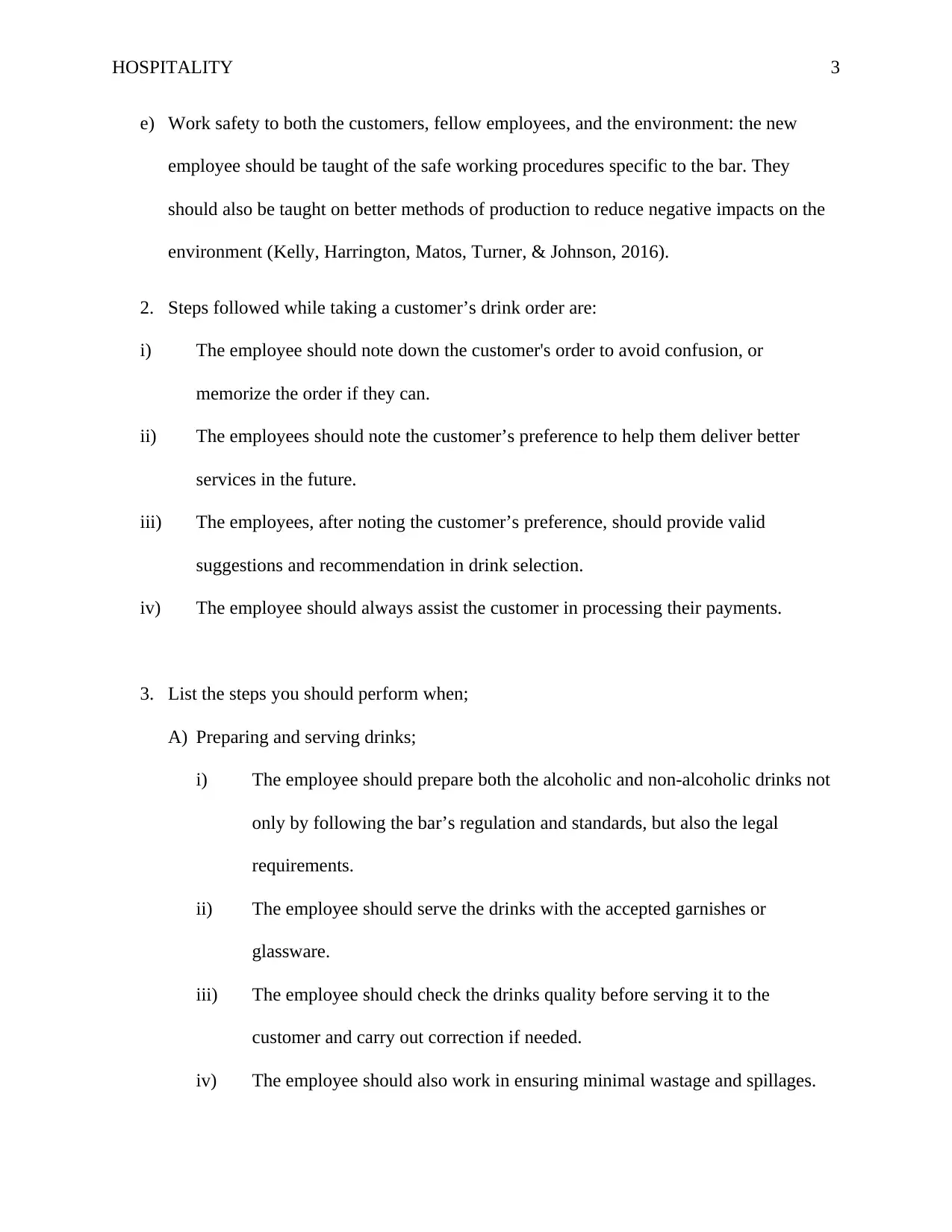
HOSPITALITY 3
e) Work safety to both the customers, fellow employees, and the environment: the new
employee should be taught of the safe working procedures specific to the bar. They
should also be taught on better methods of production to reduce negative impacts on the
environment (Kelly, Harrington, Matos, Turner, & Johnson, 2016).
2. Steps followed while taking a customer’s drink order are:
i) The employee should note down the customer's order to avoid confusion, or
memorize the order if they can.
ii) The employees should note the customer’s preference to help them deliver better
services in the future.
iii) The employees, after noting the customer’s preference, should provide valid
suggestions and recommendation in drink selection.
iv) The employee should always assist the customer in processing their payments.
3. List the steps you should perform when;
A) Preparing and serving drinks;
i) The employee should prepare both the alcoholic and non-alcoholic drinks not
only by following the bar’s regulation and standards, but also the legal
requirements.
ii) The employee should serve the drinks with the accepted garnishes or
glassware.
iii) The employee should check the drinks quality before serving it to the
customer and carry out correction if needed.
iv) The employee should also work in ensuring minimal wastage and spillages.
e) Work safety to both the customers, fellow employees, and the environment: the new
employee should be taught of the safe working procedures specific to the bar. They
should also be taught on better methods of production to reduce negative impacts on the
environment (Kelly, Harrington, Matos, Turner, & Johnson, 2016).
2. Steps followed while taking a customer’s drink order are:
i) The employee should note down the customer's order to avoid confusion, or
memorize the order if they can.
ii) The employees should note the customer’s preference to help them deliver better
services in the future.
iii) The employees, after noting the customer’s preference, should provide valid
suggestions and recommendation in drink selection.
iv) The employee should always assist the customer in processing their payments.
3. List the steps you should perform when;
A) Preparing and serving drinks;
i) The employee should prepare both the alcoholic and non-alcoholic drinks not
only by following the bar’s regulation and standards, but also the legal
requirements.
ii) The employee should serve the drinks with the accepted garnishes or
glassware.
iii) The employee should check the drinks quality before serving it to the
customer and carry out correction if needed.
iv) The employee should also work in ensuring minimal wastage and spillages.
⊘ This is a preview!⊘
Do you want full access?
Subscribe today to unlock all pages.

Trusted by 1+ million students worldwide
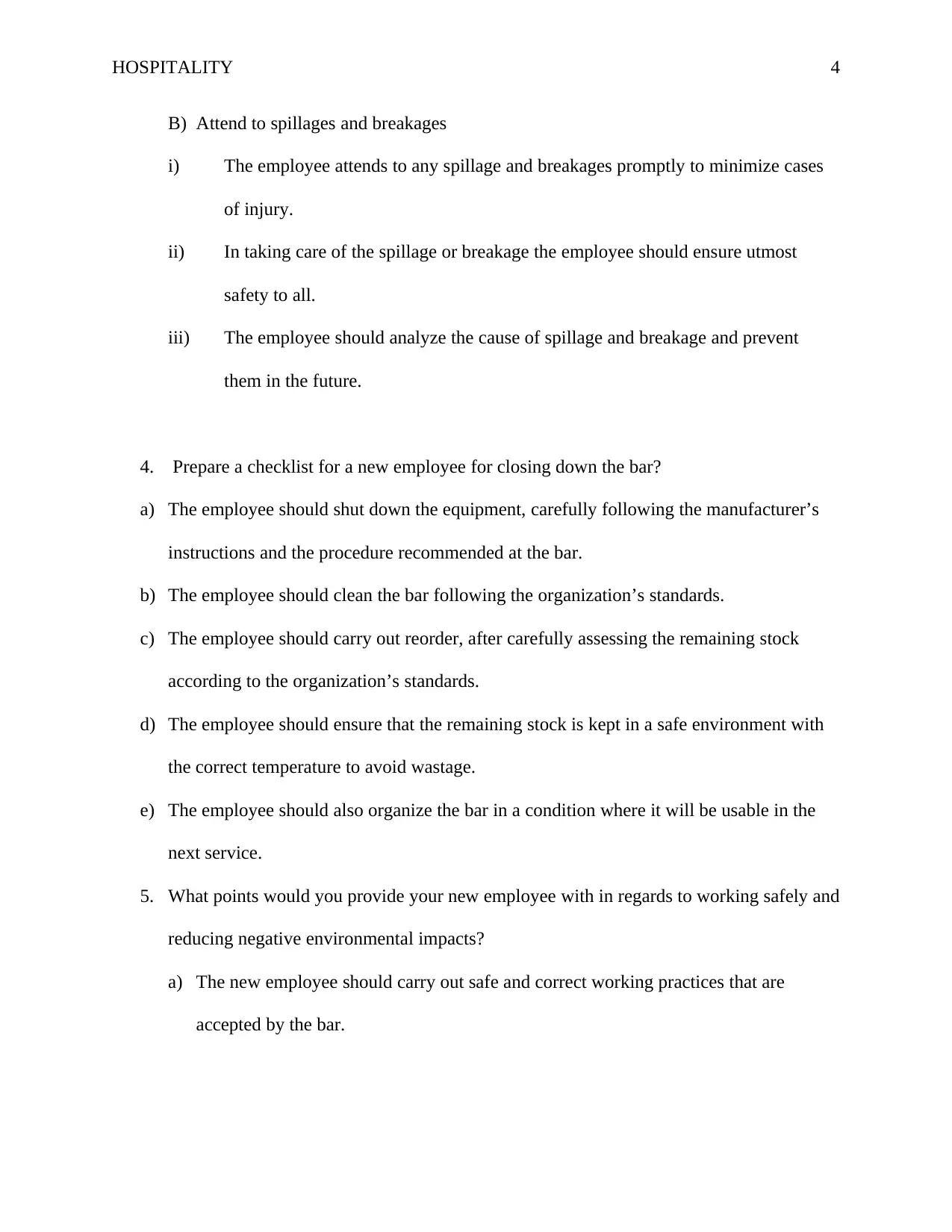
HOSPITALITY 4
B) Attend to spillages and breakages
i) The employee attends to any spillage and breakages promptly to minimize cases
of injury.
ii) In taking care of the spillage or breakage the employee should ensure utmost
safety to all.
iii) The employee should analyze the cause of spillage and breakage and prevent
them in the future.
4. Prepare a checklist for a new employee for closing down the bar?
a) The employee should shut down the equipment, carefully following the manufacturer’s
instructions and the procedure recommended at the bar.
b) The employee should clean the bar following the organization’s standards.
c) The employee should carry out reorder, after carefully assessing the remaining stock
according to the organization’s standards.
d) The employee should ensure that the remaining stock is kept in a safe environment with
the correct temperature to avoid wastage.
e) The employee should also organize the bar in a condition where it will be usable in the
next service.
5. What points would you provide your new employee with in regards to working safely and
reducing negative environmental impacts?
a) The new employee should carry out safe and correct working practices that are
accepted by the bar.
B) Attend to spillages and breakages
i) The employee attends to any spillage and breakages promptly to minimize cases
of injury.
ii) In taking care of the spillage or breakage the employee should ensure utmost
safety to all.
iii) The employee should analyze the cause of spillage and breakage and prevent
them in the future.
4. Prepare a checklist for a new employee for closing down the bar?
a) The employee should shut down the equipment, carefully following the manufacturer’s
instructions and the procedure recommended at the bar.
b) The employee should clean the bar following the organization’s standards.
c) The employee should carry out reorder, after carefully assessing the remaining stock
according to the organization’s standards.
d) The employee should ensure that the remaining stock is kept in a safe environment with
the correct temperature to avoid wastage.
e) The employee should also organize the bar in a condition where it will be usable in the
next service.
5. What points would you provide your new employee with in regards to working safely and
reducing negative environmental impacts?
a) The new employee should carry out safe and correct working practices that are
accepted by the bar.
Paraphrase This Document
Need a fresh take? Get an instant paraphrase of this document with our AI Paraphraser

HOSPITALITY 5
b) The new employee should avoid wastage by using water, energy and other production
resources efficiently. This specifically is during the preparation of drinks to avoid
unwanted environmental impacts.
c) To reduce cases of soil pollution, the new employee should re-use plastic and glass
containers.
d) The employee should be directed on safe disposal of wastes, particularly those with a
negative impact on the environment to minimize environmental pollution.
6. Why is it important to interact with customers during service?
a) The employee develops communication skills of listening and talking to customers in a
polite and friendly way.
b) The employee, over time, will identify the customers’ tastes and preference thus making
them serve customers with better efficiency.
c) The employees develop enterprise skills that promote higher sales.
7.
Drink Brand Measure Additive/mixer Glassware Garnish
Gin and
tonic
Bloom
Gin
Ratio 1:4 standard G&T Bloom Gin
Copa Glass
John's
Premium
Tonic
Bourbon
and coke
Jim Beam Ratio 1:3 orange juice Jim Beam Glass Coca-cola
b) The new employee should avoid wastage by using water, energy and other production
resources efficiently. This specifically is during the preparation of drinks to avoid
unwanted environmental impacts.
c) To reduce cases of soil pollution, the new employee should re-use plastic and glass
containers.
d) The employee should be directed on safe disposal of wastes, particularly those with a
negative impact on the environment to minimize environmental pollution.
6. Why is it important to interact with customers during service?
a) The employee develops communication skills of listening and talking to customers in a
polite and friendly way.
b) The employee, over time, will identify the customers’ tastes and preference thus making
them serve customers with better efficiency.
c) The employees develop enterprise skills that promote higher sales.
7.
Drink Brand Measure Additive/mixer Glassware Garnish
Gin and
tonic
Bloom
Gin
Ratio 1:4 standard G&T Bloom Gin
Copa Glass
John's
Premium
Tonic
Bourbon
and coke
Jim Beam Ratio 1:3 orange juice Jim Beam Glass Coca-cola
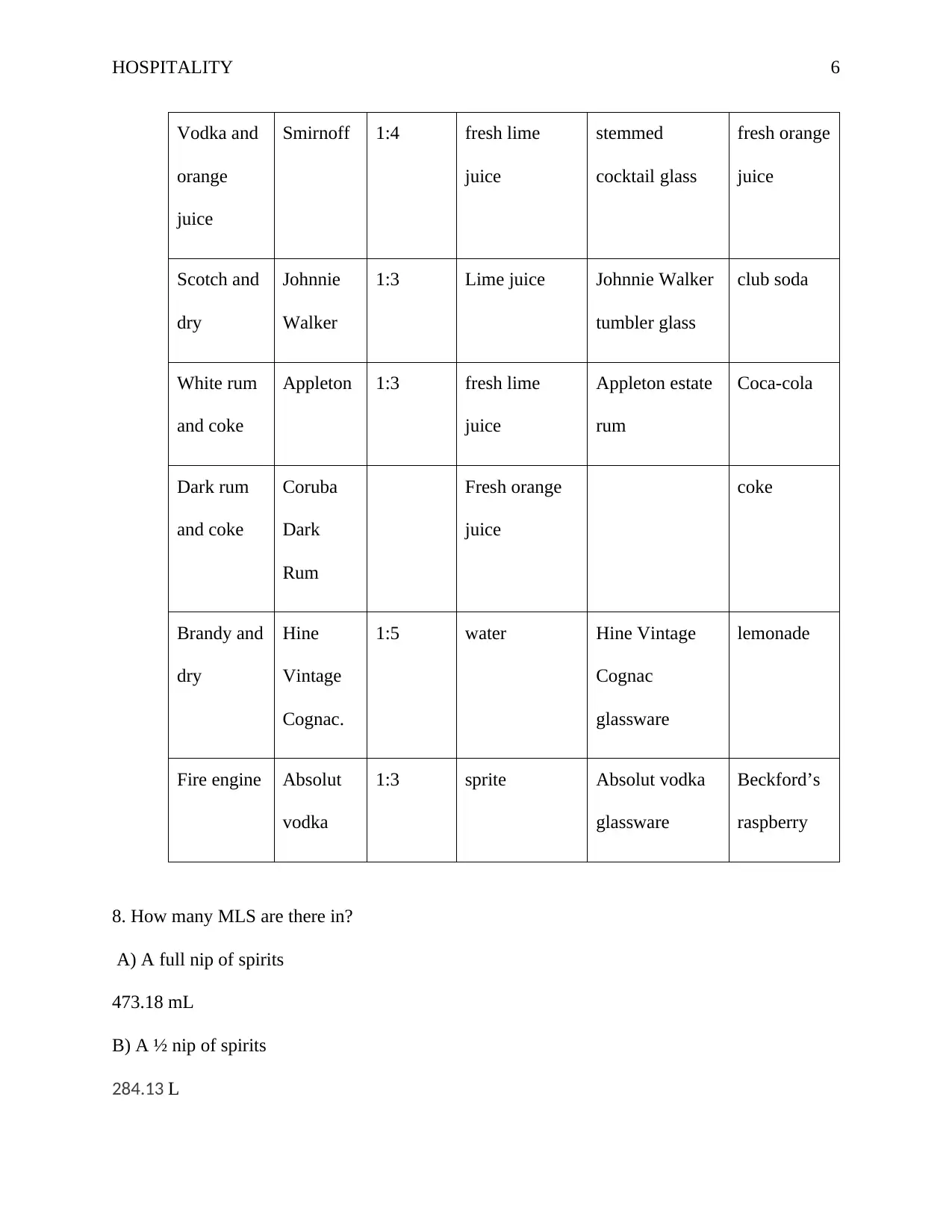
HOSPITALITY 6
Vodka and
orange
juice
Smirnoff 1:4 fresh lime
juice
stemmed
cocktail glass
fresh orange
juice
Scotch and
dry
Johnnie
Walker
1:3 Lime juice Johnnie Walker
tumbler glass
club soda
White rum
and coke
Appleton 1:3 fresh lime
juice
Appleton estate
rum
Coca-cola
Dark rum
and coke
Coruba
Dark
Rum
Fresh orange
juice
coke
Brandy and
dry
Hine
Vintage
Cognac.
1:5 water Hine Vintage
Cognac
glassware
lemonade
Fire engine Absolut
vodka
1:3 sprite Absolut vodka
glassware
Beckford’s
raspberry
8. How many MLS are there in?
A) A full nip of spirits
473.18 mL
B) A ½ nip of spirits
284.13 L
Vodka and
orange
juice
Smirnoff 1:4 fresh lime
juice
stemmed
cocktail glass
fresh orange
juice
Scotch and
dry
Johnnie
Walker
1:3 Lime juice Johnnie Walker
tumbler glass
club soda
White rum
and coke
Appleton 1:3 fresh lime
juice
Appleton estate
rum
Coca-cola
Dark rum
and coke
Coruba
Dark
Rum
Fresh orange
juice
coke
Brandy and
dry
Hine
Vintage
Cognac.
1:5 water Hine Vintage
Cognac
glassware
lemonade
Fire engine Absolut
vodka
1:3 sprite Absolut vodka
glassware
Beckford’s
raspberry
8. How many MLS are there in?
A) A full nip of spirits
473.18 mL
B) A ½ nip of spirits
284.13 L
⊘ This is a preview!⊘
Do you want full access?
Subscribe today to unlock all pages.

Trusted by 1+ million students worldwide
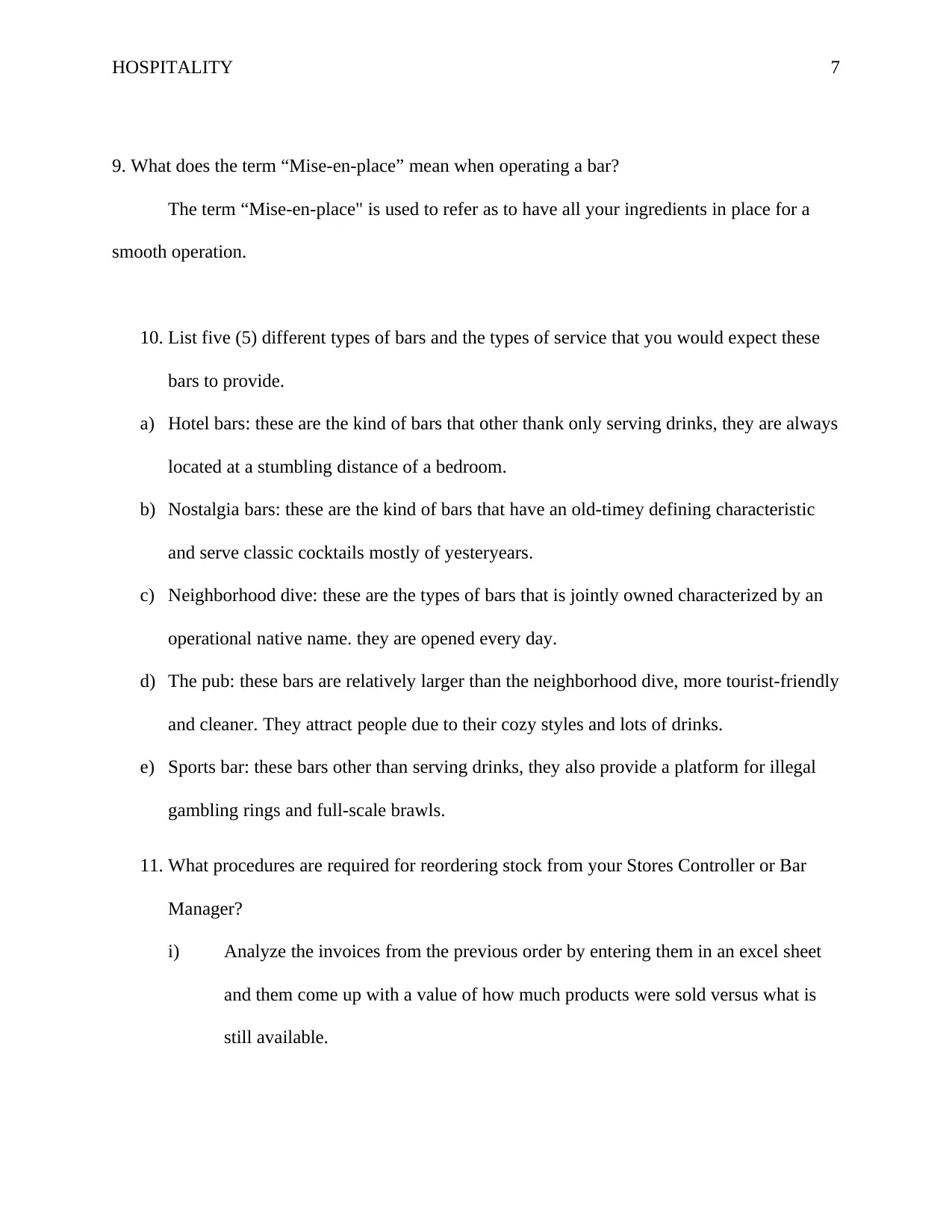
HOSPITALITY 7
9. What does the term “Mise-en-place” mean when operating a bar?
The term “Mise-en-place" is used to refer as to have all your ingredients in place for a
smooth operation.
10. List five (5) different types of bars and the types of service that you would expect these
bars to provide.
a) Hotel bars: these are the kind of bars that other thank only serving drinks, they are always
located at a stumbling distance of a bedroom.
b) Nostalgia bars: these are the kind of bars that have an old-timey defining characteristic
and serve classic cocktails mostly of yesteryears.
c) Neighborhood dive: these are the types of bars that is jointly owned characterized by an
operational native name. they are opened every day.
d) The pub: these bars are relatively larger than the neighborhood dive, more tourist-friendly
and cleaner. They attract people due to their cozy styles and lots of drinks.
e) Sports bar: these bars other than serving drinks, they also provide a platform for illegal
gambling rings and full-scale brawls.
11. What procedures are required for reordering stock from your Stores Controller or Bar
Manager?
i) Analyze the invoices from the previous order by entering them in an excel sheet
and them come up with a value of how much products were sold versus what is
still available.
9. What does the term “Mise-en-place” mean when operating a bar?
The term “Mise-en-place" is used to refer as to have all your ingredients in place for a
smooth operation.
10. List five (5) different types of bars and the types of service that you would expect these
bars to provide.
a) Hotel bars: these are the kind of bars that other thank only serving drinks, they are always
located at a stumbling distance of a bedroom.
b) Nostalgia bars: these are the kind of bars that have an old-timey defining characteristic
and serve classic cocktails mostly of yesteryears.
c) Neighborhood dive: these are the types of bars that is jointly owned characterized by an
operational native name. they are opened every day.
d) The pub: these bars are relatively larger than the neighborhood dive, more tourist-friendly
and cleaner. They attract people due to their cozy styles and lots of drinks.
e) Sports bar: these bars other than serving drinks, they also provide a platform for illegal
gambling rings and full-scale brawls.
11. What procedures are required for reordering stock from your Stores Controller or Bar
Manager?
i) Analyze the invoices from the previous order by entering them in an excel sheet
and them come up with a value of how much products were sold versus what is
still available.
Paraphrase This Document
Need a fresh take? Get an instant paraphrase of this document with our AI Paraphraser
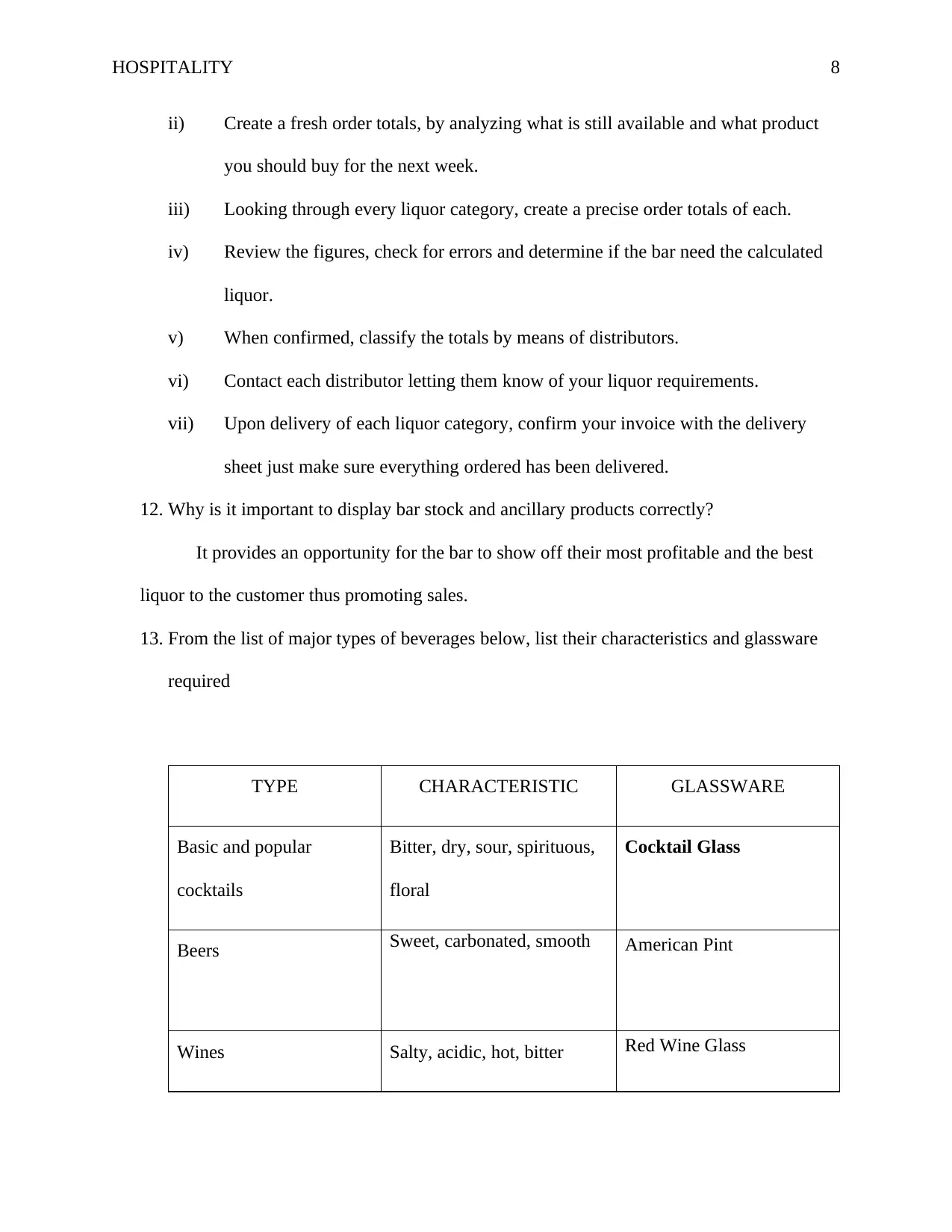
HOSPITALITY 8
ii) Create a fresh order totals, by analyzing what is still available and what product
you should buy for the next week.
iii) Looking through every liquor category, create a precise order totals of each.
iv) Review the figures, check for errors and determine if the bar need the calculated
liquor.
v) When confirmed, classify the totals by means of distributors.
vi) Contact each distributor letting them know of your liquor requirements.
vii) Upon delivery of each liquor category, confirm your invoice with the delivery
sheet just make sure everything ordered has been delivered.
12. Why is it important to display bar stock and ancillary products correctly?
It provides an opportunity for the bar to show off their most profitable and the best
liquor to the customer thus promoting sales.
13. From the list of major types of beverages below, list their characteristics and glassware
required
TYPE CHARACTERISTIC GLASSWARE
Basic and popular
cocktails
Bitter, dry, sour, spirituous,
floral
Cocktail Glass
Beers Sweet, carbonated, smooth American Pint
Wines Salty, acidic, hot, bitter Red Wine Glass
ii) Create a fresh order totals, by analyzing what is still available and what product
you should buy for the next week.
iii) Looking through every liquor category, create a precise order totals of each.
iv) Review the figures, check for errors and determine if the bar need the calculated
liquor.
v) When confirmed, classify the totals by means of distributors.
vi) Contact each distributor letting them know of your liquor requirements.
vii) Upon delivery of each liquor category, confirm your invoice with the delivery
sheet just make sure everything ordered has been delivered.
12. Why is it important to display bar stock and ancillary products correctly?
It provides an opportunity for the bar to show off their most profitable and the best
liquor to the customer thus promoting sales.
13. From the list of major types of beverages below, list their characteristics and glassware
required
TYPE CHARACTERISTIC GLASSWARE
Basic and popular
cocktails
Bitter, dry, sour, spirituous,
floral
Cocktail Glass
Beers Sweet, carbonated, smooth American Pint
Wines Salty, acidic, hot, bitter Red Wine Glass
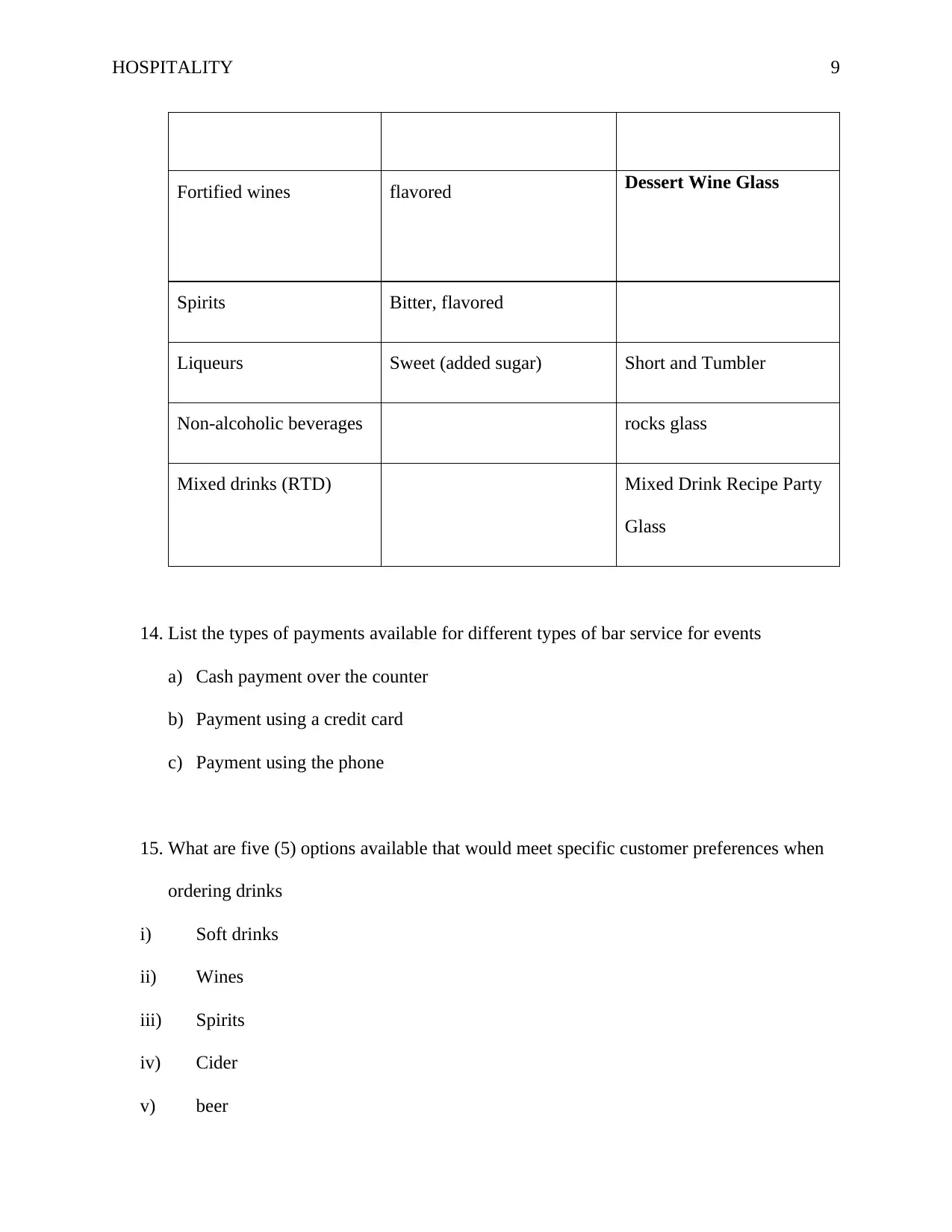
HOSPITALITY 9
Fortified wines flavored Dessert Wine Glass
Spirits Bitter, flavored
Liqueurs Sweet (added sugar) Short and Tumbler
Non-alcoholic beverages rocks glass
Mixed drinks (RTD) Mixed Drink Recipe Party
Glass
14. List the types of payments available for different types of bar service for events
a) Cash payment over the counter
b) Payment using a credit card
c) Payment using the phone
15. What are five (5) options available that would meet specific customer preferences when
ordering drinks
i) Soft drinks
ii) Wines
iii) Spirits
iv) Cider
v) beer
Fortified wines flavored Dessert Wine Glass
Spirits Bitter, flavored
Liqueurs Sweet (added sugar) Short and Tumbler
Non-alcoholic beverages rocks glass
Mixed drinks (RTD) Mixed Drink Recipe Party
Glass
14. List the types of payments available for different types of bar service for events
a) Cash payment over the counter
b) Payment using a credit card
c) Payment using the phone
15. What are five (5) options available that would meet specific customer preferences when
ordering drinks
i) Soft drinks
ii) Wines
iii) Spirits
iv) Cider
v) beer
⊘ This is a preview!⊘
Do you want full access?
Subscribe today to unlock all pages.

Trusted by 1+ million students worldwide
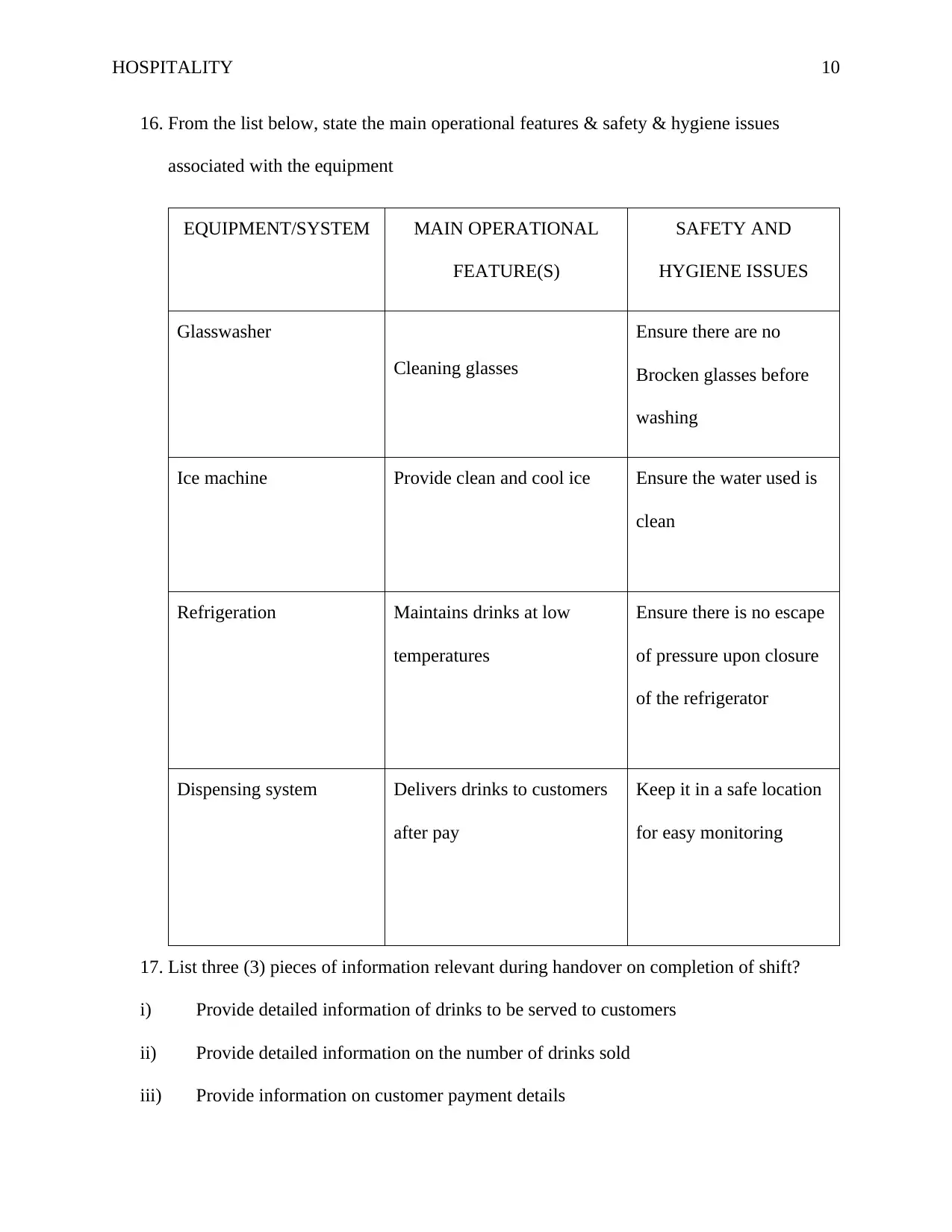
HOSPITALITY 10
16. From the list below, state the main operational features & safety & hygiene issues
associated with the equipment
EQUIPMENT/SYSTEM MAIN OPERATIONAL
FEATURE(S)
SAFETY AND
HYGIENE ISSUES
Glasswasher
Cleaning glasses
Ensure there are no
Brocken glasses before
washing
Ice machine Provide clean and cool ice Ensure the water used is
clean
Refrigeration Maintains drinks at low
temperatures
Ensure there is no escape
of pressure upon closure
of the refrigerator
Dispensing system Delivers drinks to customers
after pay
Keep it in a safe location
for easy monitoring
17. List three (3) pieces of information relevant during handover on completion of shift?
i) Provide detailed information of drinks to be served to customers
ii) Provide detailed information on the number of drinks sold
iii) Provide information on customer payment details
16. From the list below, state the main operational features & safety & hygiene issues
associated with the equipment
EQUIPMENT/SYSTEM MAIN OPERATIONAL
FEATURE(S)
SAFETY AND
HYGIENE ISSUES
Glasswasher
Cleaning glasses
Ensure there are no
Brocken glasses before
washing
Ice machine Provide clean and cool ice Ensure the water used is
clean
Refrigeration Maintains drinks at low
temperatures
Ensure there is no escape
of pressure upon closure
of the refrigerator
Dispensing system Delivers drinks to customers
after pay
Keep it in a safe location
for easy monitoring
17. List three (3) pieces of information relevant during handover on completion of shift?
i) Provide detailed information of drinks to be served to customers
ii) Provide detailed information on the number of drinks sold
iii) Provide information on customer payment details
Paraphrase This Document
Need a fresh take? Get an instant paraphrase of this document with our AI Paraphraser
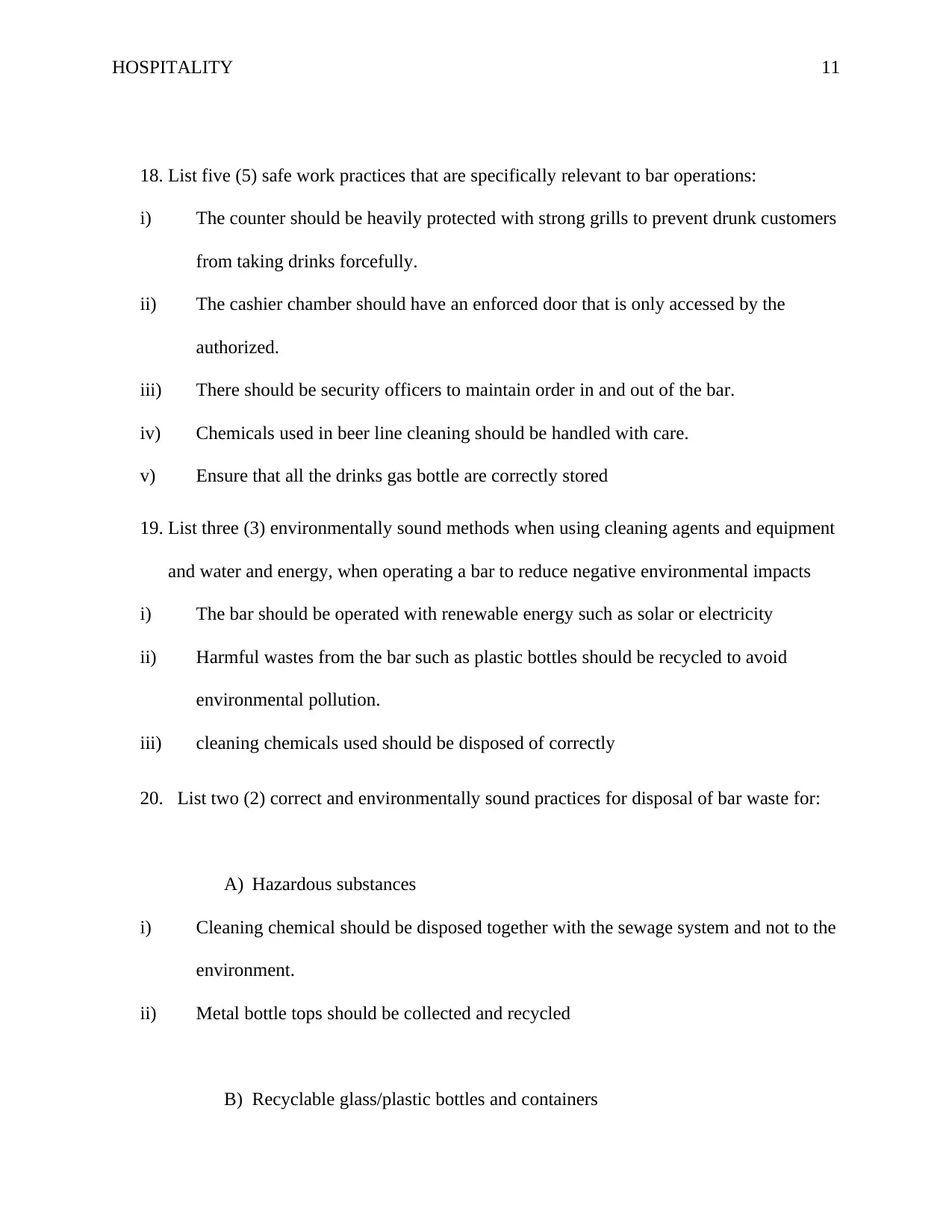
HOSPITALITY 11
18. List five (5) safe work practices that are specifically relevant to bar operations:
i) The counter should be heavily protected with strong grills to prevent drunk customers
from taking drinks forcefully.
ii) The cashier chamber should have an enforced door that is only accessed by the
authorized.
iii) There should be security officers to maintain order in and out of the bar.
iv) Chemicals used in beer line cleaning should be handled with care.
v) Ensure that all the drinks gas bottle are correctly stored
19. List three (3) environmentally sound methods when using cleaning agents and equipment
and water and energy, when operating a bar to reduce negative environmental impacts
i) The bar should be operated with renewable energy such as solar or electricity
ii) Harmful wastes from the bar such as plastic bottles should be recycled to avoid
environmental pollution.
iii) cleaning chemicals used should be disposed of correctly
20. List two (2) correct and environmentally sound practices for disposal of bar waste for:
A) Hazardous substances
i) Cleaning chemical should be disposed together with the sewage system and not to the
environment.
ii) Metal bottle tops should be collected and recycled
B) Recyclable glass/plastic bottles and containers
18. List five (5) safe work practices that are specifically relevant to bar operations:
i) The counter should be heavily protected with strong grills to prevent drunk customers
from taking drinks forcefully.
ii) The cashier chamber should have an enforced door that is only accessed by the
authorized.
iii) There should be security officers to maintain order in and out of the bar.
iv) Chemicals used in beer line cleaning should be handled with care.
v) Ensure that all the drinks gas bottle are correctly stored
19. List three (3) environmentally sound methods when using cleaning agents and equipment
and water and energy, when operating a bar to reduce negative environmental impacts
i) The bar should be operated with renewable energy such as solar or electricity
ii) Harmful wastes from the bar such as plastic bottles should be recycled to avoid
environmental pollution.
iii) cleaning chemicals used should be disposed of correctly
20. List two (2) correct and environmentally sound practices for disposal of bar waste for:
A) Hazardous substances
i) Cleaning chemical should be disposed together with the sewage system and not to the
environment.
ii) Metal bottle tops should be collected and recycled
B) Recyclable glass/plastic bottles and containers

HOSPITALITY 12
i) The plastic bottles should be reused
ii) The plastic bottle should be taken back to the company for recycling.
Section B
Question 1: List 3 items (perishables and equipment) you need as part of coffee mise-en-place.
i) The processed coffee
ii) A heating element (gas cooker)
iii) water
Question 2: Identify and describe three storage conditions for roasted coffee beans.
i) Store in moisture free environment: Coffee Is hygroscopic, meaning it has the
property of absorbing moisture from the environment thus the roasted beans should
be stored in a less moist storage location.
ii) Store the roasted beans at room temperature: coffee beans lose its fats at high
temperatures affecting its overall flavor.
iii) Store the coffee beans in normal air condition: since coffee beans lose their aromatic
flavor just like wines, an ideal storage location is where the room air has a high
pressure and calm.
Question 3: Identify four coffee styles that can be produced from the espresso machine.
i) Café Americano
ii) Cappuccino
iii) Long Black
iv) Vienna
Question 4: What are a Barista and list two of his/her responsibilities?
i) The plastic bottles should be reused
ii) The plastic bottle should be taken back to the company for recycling.
Section B
Question 1: List 3 items (perishables and equipment) you need as part of coffee mise-en-place.
i) The processed coffee
ii) A heating element (gas cooker)
iii) water
Question 2: Identify and describe three storage conditions for roasted coffee beans.
i) Store in moisture free environment: Coffee Is hygroscopic, meaning it has the
property of absorbing moisture from the environment thus the roasted beans should
be stored in a less moist storage location.
ii) Store the roasted beans at room temperature: coffee beans lose its fats at high
temperatures affecting its overall flavor.
iii) Store the coffee beans in normal air condition: since coffee beans lose their aromatic
flavor just like wines, an ideal storage location is where the room air has a high
pressure and calm.
Question 3: Identify four coffee styles that can be produced from the espresso machine.
i) Café Americano
ii) Cappuccino
iii) Long Black
iv) Vienna
Question 4: What are a Barista and list two of his/her responsibilities?
⊘ This is a preview!⊘
Do you want full access?
Subscribe today to unlock all pages.

Trusted by 1+ million students worldwide
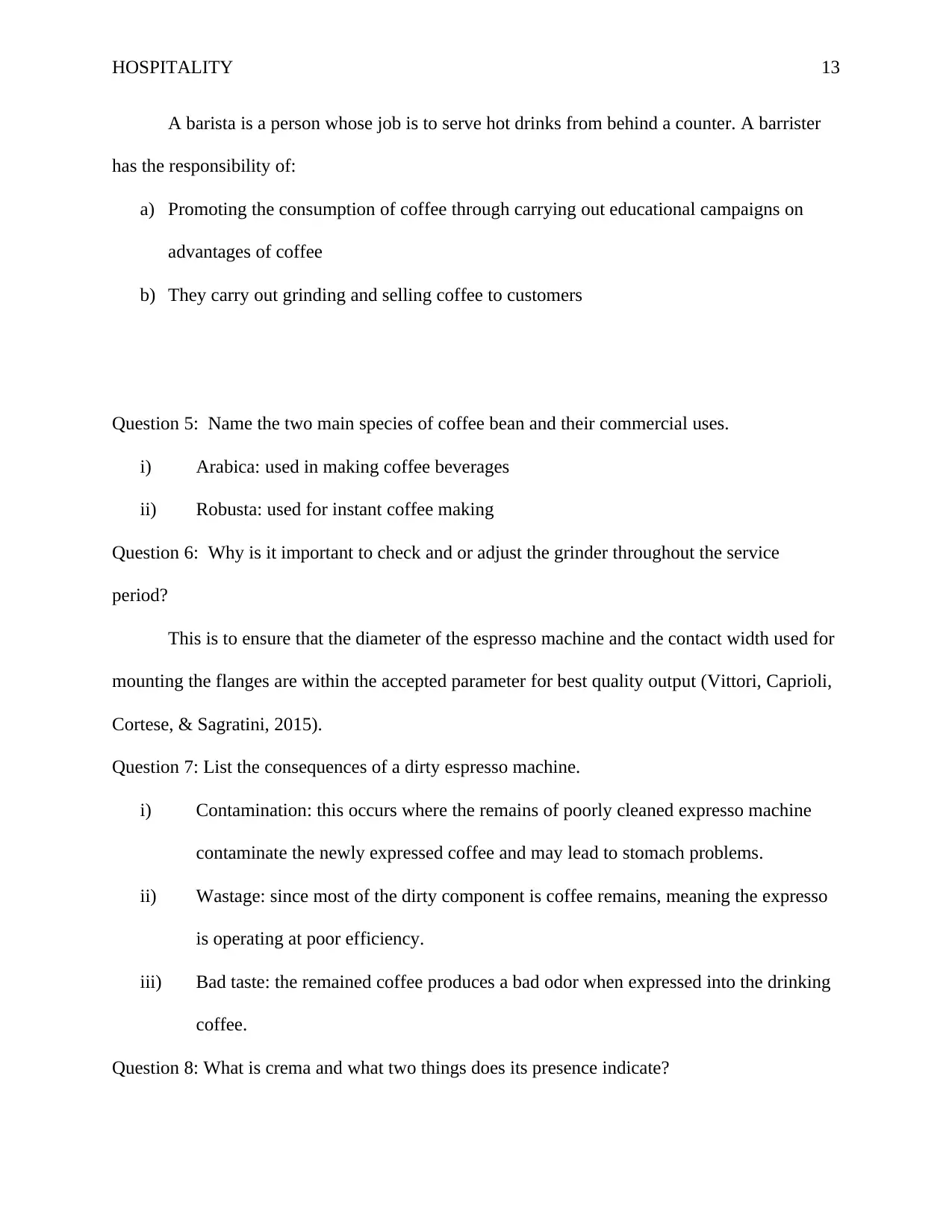
HOSPITALITY 13
A barista is a person whose job is to serve hot drinks from behind a counter. A barrister
has the responsibility of:
a) Promoting the consumption of coffee through carrying out educational campaigns on
advantages of coffee
b) They carry out grinding and selling coffee to customers
Question 5: Name the two main species of coffee bean and their commercial uses.
i) Arabica: used in making coffee beverages
ii) Robusta: used for instant coffee making
Question 6: Why is it important to check and or adjust the grinder throughout the service
period?
This is to ensure that the diameter of the espresso machine and the contact width used for
mounting the flanges are within the accepted parameter for best quality output (Vittori, Caprioli,
Cortese, & Sagratini, 2015).
Question 7: List the consequences of a dirty espresso machine.
i) Contamination: this occurs where the remains of poorly cleaned expresso machine
contaminate the newly expressed coffee and may lead to stomach problems.
ii) Wastage: since most of the dirty component is coffee remains, meaning the expresso
is operating at poor efficiency.
iii) Bad taste: the remained coffee produces a bad odor when expressed into the drinking
coffee.
Question 8: What is crema and what two things does its presence indicate?
A barista is a person whose job is to serve hot drinks from behind a counter. A barrister
has the responsibility of:
a) Promoting the consumption of coffee through carrying out educational campaigns on
advantages of coffee
b) They carry out grinding and selling coffee to customers
Question 5: Name the two main species of coffee bean and their commercial uses.
i) Arabica: used in making coffee beverages
ii) Robusta: used for instant coffee making
Question 6: Why is it important to check and or adjust the grinder throughout the service
period?
This is to ensure that the diameter of the espresso machine and the contact width used for
mounting the flanges are within the accepted parameter for best quality output (Vittori, Caprioli,
Cortese, & Sagratini, 2015).
Question 7: List the consequences of a dirty espresso machine.
i) Contamination: this occurs where the remains of poorly cleaned expresso machine
contaminate the newly expressed coffee and may lead to stomach problems.
ii) Wastage: since most of the dirty component is coffee remains, meaning the expresso
is operating at poor efficiency.
iii) Bad taste: the remained coffee produces a bad odor when expressed into the drinking
coffee.
Question 8: What is crema and what two things does its presence indicate?
Paraphrase This Document
Need a fresh take? Get an instant paraphrase of this document with our AI Paraphraser
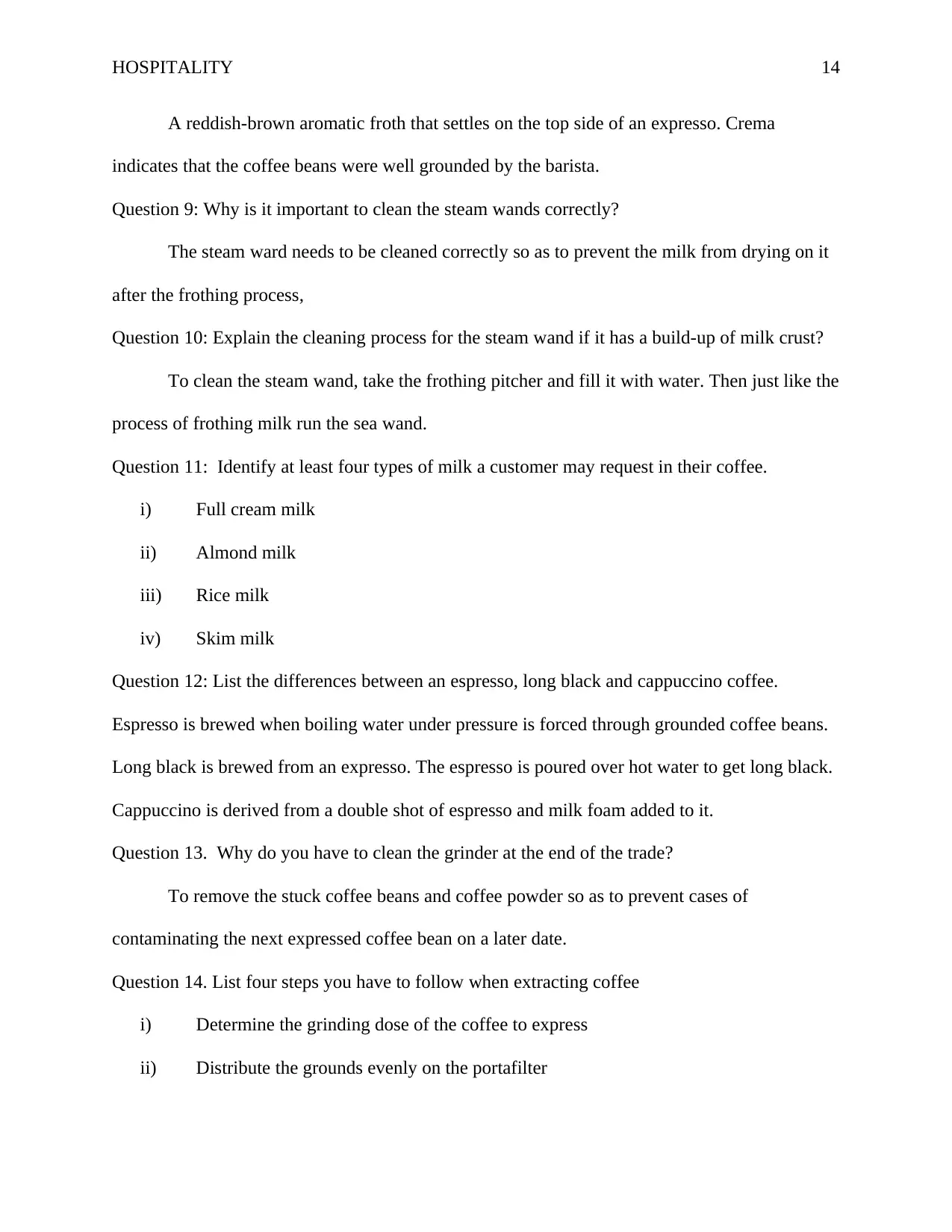
HOSPITALITY 14
A reddish-brown aromatic froth that settles on the top side of an expresso. Crema
indicates that the coffee beans were well grounded by the barista.
Question 9: Why is it important to clean the steam wands correctly?
The steam ward needs to be cleaned correctly so as to prevent the milk from drying on it
after the frothing process,
Question 10: Explain the cleaning process for the steam wand if it has a build-up of milk crust?
To clean the steam wand, take the frothing pitcher and fill it with water. Then just like the
process of frothing milk run the sea wand.
Question 11: Identify at least four types of milk a customer may request in their coffee.
i) Full cream milk
ii) Almond milk
iii) Rice milk
iv) Skim milk
Question 12: List the differences between an espresso, long black and cappuccino coffee.
Espresso is brewed when boiling water under pressure is forced through grounded coffee beans.
Long black is brewed from an expresso. The espresso is poured over hot water to get long black.
Cappuccino is derived from a double shot of espresso and milk foam added to it.
Question 13. Why do you have to clean the grinder at the end of the trade?
To remove the stuck coffee beans and coffee powder so as to prevent cases of
contaminating the next expressed coffee bean on a later date.
Question 14. List four steps you have to follow when extracting coffee
i) Determine the grinding dose of the coffee to express
ii) Distribute the grounds evenly on the portafilter
A reddish-brown aromatic froth that settles on the top side of an expresso. Crema
indicates that the coffee beans were well grounded by the barista.
Question 9: Why is it important to clean the steam wands correctly?
The steam ward needs to be cleaned correctly so as to prevent the milk from drying on it
after the frothing process,
Question 10: Explain the cleaning process for the steam wand if it has a build-up of milk crust?
To clean the steam wand, take the frothing pitcher and fill it with water. Then just like the
process of frothing milk run the sea wand.
Question 11: Identify at least four types of milk a customer may request in their coffee.
i) Full cream milk
ii) Almond milk
iii) Rice milk
iv) Skim milk
Question 12: List the differences between an espresso, long black and cappuccino coffee.
Espresso is brewed when boiling water under pressure is forced through grounded coffee beans.
Long black is brewed from an expresso. The espresso is poured over hot water to get long black.
Cappuccino is derived from a double shot of espresso and milk foam added to it.
Question 13. Why do you have to clean the grinder at the end of the trade?
To remove the stuck coffee beans and coffee powder so as to prevent cases of
contaminating the next expressed coffee bean on a later date.
Question 14. List four steps you have to follow when extracting coffee
i) Determine the grinding dose of the coffee to express
ii) Distribute the grounds evenly on the portafilter
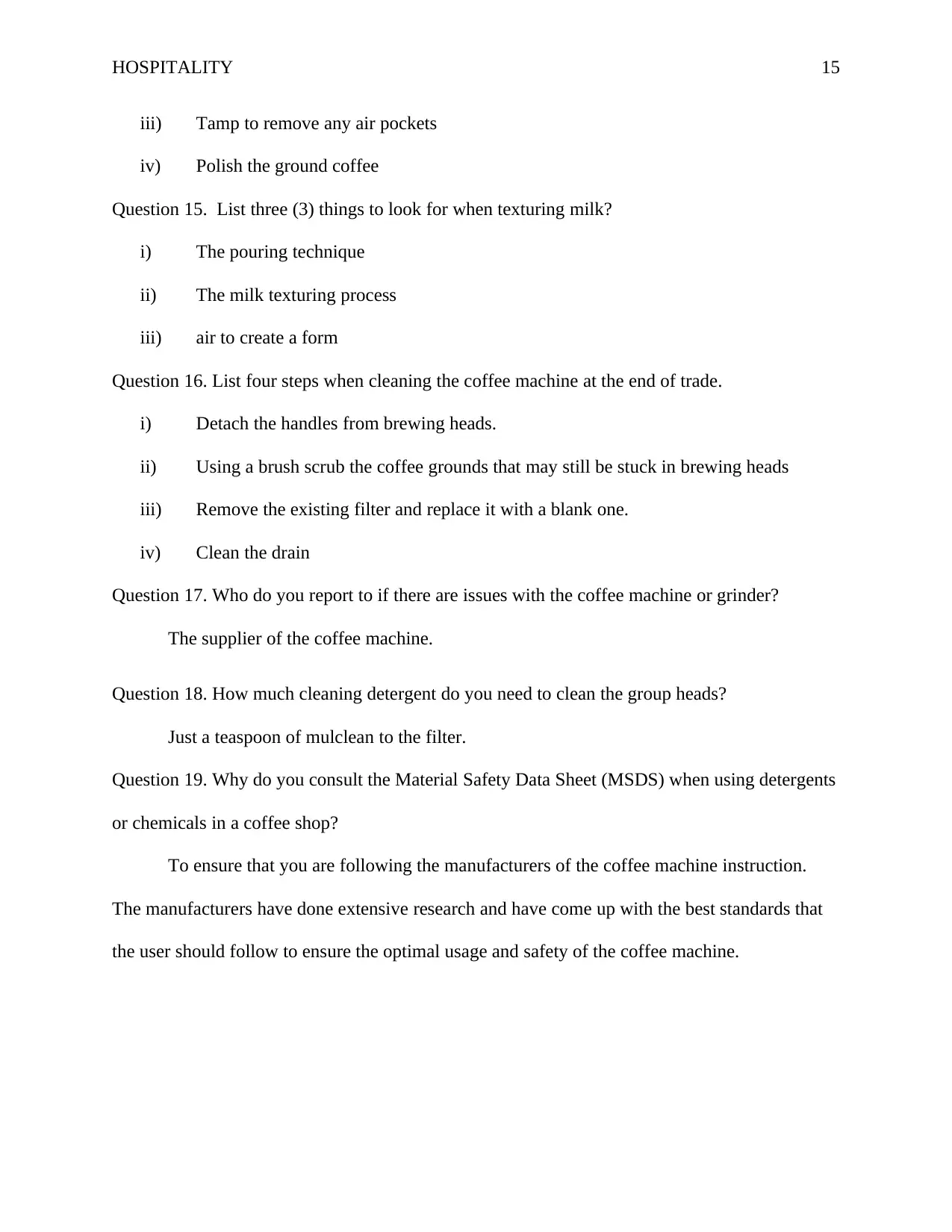
HOSPITALITY 15
iii) Tamp to remove any air pockets
iv) Polish the ground coffee
Question 15. List three (3) things to look for when texturing milk?
i) The pouring technique
ii) The milk texturing process
iii) air to create a form
Question 16. List four steps when cleaning the coffee machine at the end of trade.
i) Detach the handles from brewing heads.
ii) Using a brush scrub the coffee grounds that may still be stuck in brewing heads
iii) Remove the existing filter and replace it with a blank one.
iv) Clean the drain
Question 17. Who do you report to if there are issues with the coffee machine or grinder?
The supplier of the coffee machine.
Question 18. How much cleaning detergent do you need to clean the group heads?
Just a teaspoon of mulclean to the filter.
Question 19. Why do you consult the Material Safety Data Sheet (MSDS) when using detergents
or chemicals in a coffee shop?
To ensure that you are following the manufacturers of the coffee machine instruction.
The manufacturers have done extensive research and have come up with the best standards that
the user should follow to ensure the optimal usage and safety of the coffee machine.
iii) Tamp to remove any air pockets
iv) Polish the ground coffee
Question 15. List three (3) things to look for when texturing milk?
i) The pouring technique
ii) The milk texturing process
iii) air to create a form
Question 16. List four steps when cleaning the coffee machine at the end of trade.
i) Detach the handles from brewing heads.
ii) Using a brush scrub the coffee grounds that may still be stuck in brewing heads
iii) Remove the existing filter and replace it with a blank one.
iv) Clean the drain
Question 17. Who do you report to if there are issues with the coffee machine or grinder?
The supplier of the coffee machine.
Question 18. How much cleaning detergent do you need to clean the group heads?
Just a teaspoon of mulclean to the filter.
Question 19. Why do you consult the Material Safety Data Sheet (MSDS) when using detergents
or chemicals in a coffee shop?
To ensure that you are following the manufacturers of the coffee machine instruction.
The manufacturers have done extensive research and have come up with the best standards that
the user should follow to ensure the optimal usage and safety of the coffee machine.
⊘ This is a preview!⊘
Do you want full access?
Subscribe today to unlock all pages.

Trusted by 1+ million students worldwide
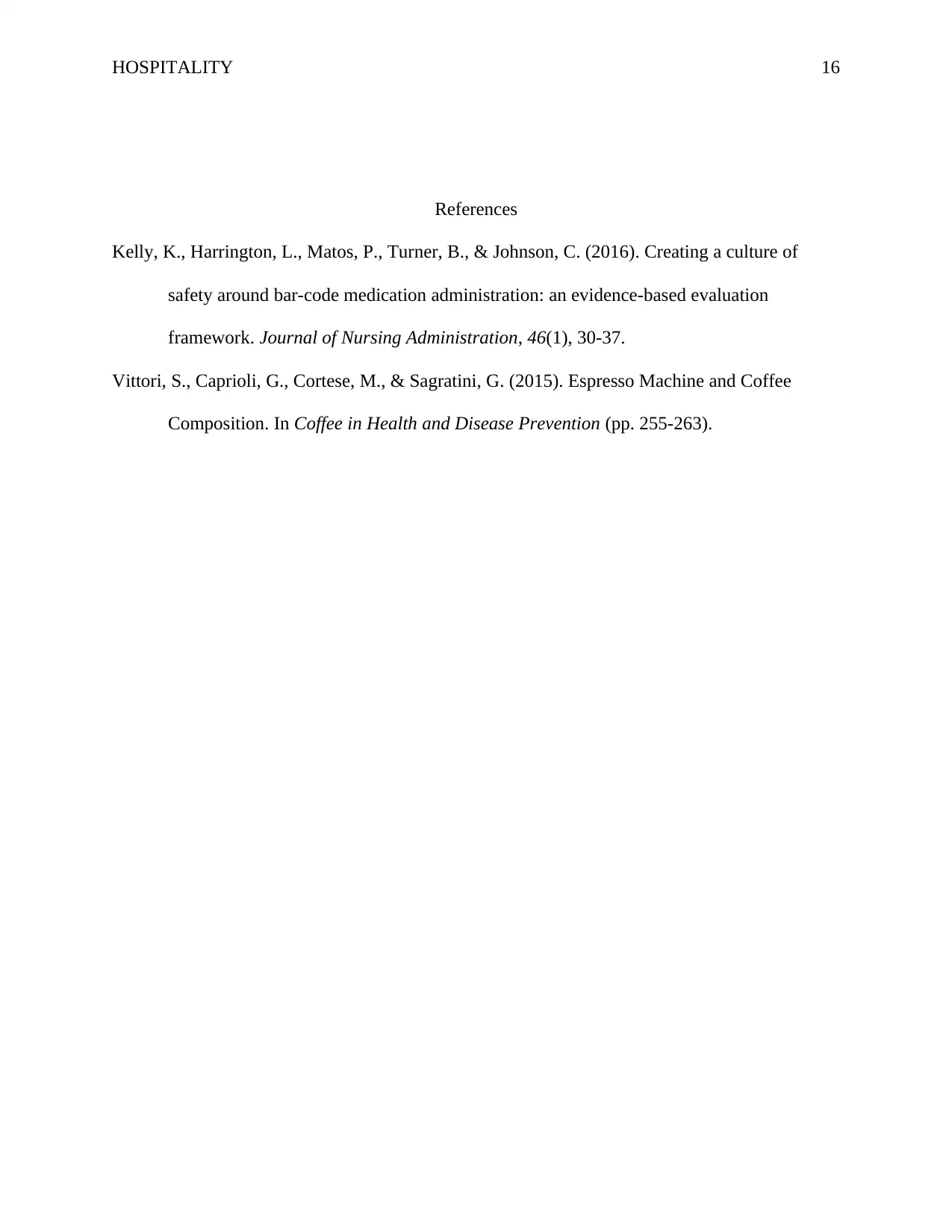
HOSPITALITY 16
References
Kelly, K., Harrington, L., Matos, P., Turner, B., & Johnson, C. (2016). Creating a culture of
safety around bar-code medication administration: an evidence-based evaluation
framework. Journal of Nursing Administration, 46(1), 30-37.
Vittori, S., Caprioli, G., Cortese, M., & Sagratini, G. (2015). Espresso Machine and Coffee
Composition. In Coffee in Health and Disease Prevention (pp. 255-263).
References
Kelly, K., Harrington, L., Matos, P., Turner, B., & Johnson, C. (2016). Creating a culture of
safety around bar-code medication administration: an evidence-based evaluation
framework. Journal of Nursing Administration, 46(1), 30-37.
Vittori, S., Caprioli, G., Cortese, M., & Sagratini, G. (2015). Espresso Machine and Coffee
Composition. In Coffee in Health and Disease Prevention (pp. 255-263).
1 out of 16
Related Documents
Your All-in-One AI-Powered Toolkit for Academic Success.
+13062052269
info@desklib.com
Available 24*7 on WhatsApp / Email
![[object Object]](/_next/static/media/star-bottom.7253800d.svg)
Unlock your academic potential
© 2024 | Zucol Services PVT LTD | All rights reserved.





